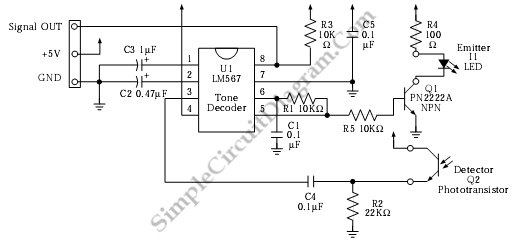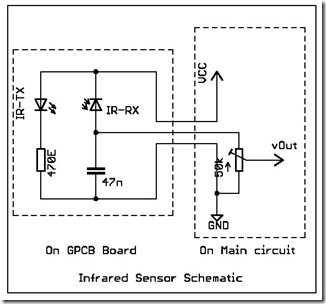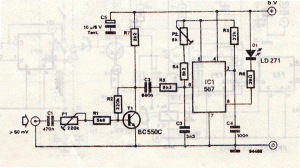
Infrared Detection with 74HC04

The two basic parts for working with IR are the emitter and the detector. The emitter is typically an LED that emits near-infrared light. A typical wavelength is 880nm, which is just beyond the human eye's ability to see. Many suppliers, new and surplus, can provide you with sources of LED emitters. A typical IR detection system will use two emitters. By controlling when the emitters are active, the detection system can determine simple directional information: Left, Right, or Front. There are several types of detectors for IR light. There are photo-diodes, photo-transistors, and a couple others. Usually, you buy IR emitter/detector pairs, which are tuned for each other. This is recommended when buying surplus, since chances are someo
An infrared (IR) detection system typically consists of two main components: the emitter and the detector. The emitter is generally a near-infrared light-emitting diode (LED) that operates at a wavelength of approximately 880 nm. This wavelength is strategically chosen as it falls just beyond the visible spectrum, making it undetectable to the human eye while still being effective for various applications, including remote control systems and obstacle detection.
In a standard configuration, two IR emitters are utilized. By controlling the activation of these emitters, the system can ascertain directional information, such as whether an object is located to the left, right, or directly in front of the system. This capability is particularly useful in robotics and automation, where understanding the position of obstacles or targets is crucial.
The detection side of the system can incorporate several types of sensors, including photodiodes and phototransistors. These devices are sensitive to infrared light and can convert the received IR signals into electrical signals for further processing. It is common practice to use matched pairs of IR emitters and detectors, as they are specifically tuned to work together, ensuring optimal performance and sensitivity.
When sourcing components, particularly from surplus suppliers, it is advisable to purchase these emitter/detector pairs to guarantee compatibility and functionality. The choice of components can significantly impact the effectiveness of the IR detection system, influencing factors such as range, response time, and environmental resilience. Proper circuit design should include considerations for power supply, signal amplification, and noise filtering to enhance the reliability and accuracy of the IR detection system.The two basic parts for working with IR are the emitter and the detector. The emitter is typically an LED that emits near-infrared light. A typical wavelength is 880nm, which is just beyond the human eyes ability to see. Many suppliers, new and surplus, can provide you with sources of LED emitters. A typical IR detection system will use two emitters. By controlling when the emitters are active, the detection system can determine simple directional information: Left, Right, or Front. There are several types of detectors for IR light. There are photo-diodes, photo-transistors, and a couple others. Usually, you buy IR emitter/detector pairs, which are tuned for each other. This is recommended when buying surplus, since chances are someo 🔗 External reference
An infrared (IR) detection system typically consists of two main components: the emitter and the detector. The emitter is generally a near-infrared light-emitting diode (LED) that operates at a wavelength of approximately 880 nm. This wavelength is strategically chosen as it falls just beyond the visible spectrum, making it undetectable to the human eye while still being effective for various applications, including remote control systems and obstacle detection.
In a standard configuration, two IR emitters are utilized. By controlling the activation of these emitters, the system can ascertain directional information, such as whether an object is located to the left, right, or directly in front of the system. This capability is particularly useful in robotics and automation, where understanding the position of obstacles or targets is crucial.
The detection side of the system can incorporate several types of sensors, including photodiodes and phototransistors. These devices are sensitive to infrared light and can convert the received IR signals into electrical signals for further processing. It is common practice to use matched pairs of IR emitters and detectors, as they are specifically tuned to work together, ensuring optimal performance and sensitivity.
When sourcing components, particularly from surplus suppliers, it is advisable to purchase these emitter/detector pairs to guarantee compatibility and functionality. The choice of components can significantly impact the effectiveness of the IR detection system, influencing factors such as range, response time, and environmental resilience. Proper circuit design should include considerations for power supply, signal amplification, and noise filtering to enhance the reliability and accuracy of the IR detection system.The two basic parts for working with IR are the emitter and the detector. The emitter is typically an LED that emits near-infrared light. A typical wavelength is 880nm, which is just beyond the human eyes ability to see. Many suppliers, new and surplus, can provide you with sources of LED emitters. A typical IR detection system will use two emitters. By controlling when the emitters are active, the detection system can determine simple directional information: Left, Right, or Front. There are several types of detectors for IR light. There are photo-diodes, photo-transistors, and a couple others. Usually, you buy IR emitter/detector pairs, which are tuned for each other. This is recommended when buying surplus, since chances are someo 🔗 External reference





